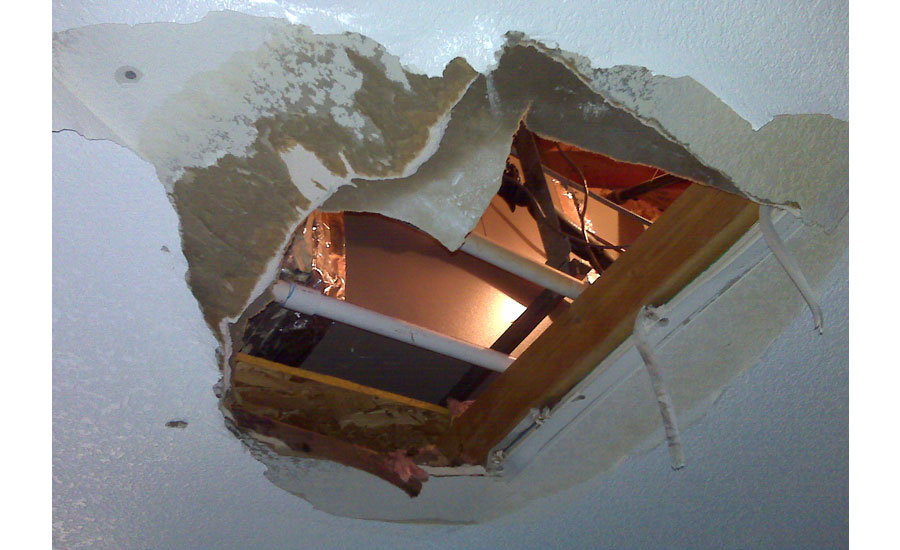Did you know that an HVAC system can produce up to 20 gallons of water a day? Due to this fact, as much as 90 percent of central air conditioning service calls are to address water leaks caused by condensation. If the water is not dispelled properly, leaks occur mainly because: (1) there’s a crack or hole in the overflow drain pan, (2) there’s a clogged condensate drain line and water backs up and floods the overflow pan, or (3) the air filter is clogged with dirt, which causes the evaporator coil to ice up and then drip water.
One of the many functions of an HVAC system is to dehumidify the air as a byproduct of the cooling method. The HVAC system dehumidifies the environment by removing moisture from the air, collecting condensation on the evaporator coil that then drips into the condensation pan, and drains it through a condensate drain pipe to the outside of the home where hopefully it is dispelled in an environmentally conscious manner.
WHAT CAUSES AN A/C CONDENSATE DRAIN LINE TO CLOG?
In addition to condensation created by the HVAC system, the drain line can fill with dust particles as well as bacteria causing mold, mildew, and algae to grow in the condensation drain year-round, even with a filter. Mold in the condensate drain system feeds off tiny airborne organic particulates sucked in through the return ducts and produces millions of mold spores. A mold colony is conducive to dispersing spores into the airflow in the supply ducts, and to contaminate the air throughout a home. Allergic symptoms and other respiratory distress may result in susceptible individuals. In addition, mold growth originating in the condensate drain collector frequently expands into the evaporator coil, obstructing narrow air passages and strangling system airflow.
The drain eventually can become clogged with a sludge and grime that is called Zoola, a mold riddled gunk. As Zoola accumulates in the condensate drain it becomes constrained and eventually will block the drain line. This can cause the HVAC system to back with water, flooding the overflow pan, causing water damage inside the house and potentially leading to thousands of dollars in repair to drywall, ceilings, and/or floors.
Even in the months during which an air conditioning system is not in use, particularly for non-heat pump systems that perform cooling only, condensate and accumulated dust and debris that rests in the condensate drain trap can convert to a dried plug of Zoola, as the water portion of the block evaporates.
In addition, improperly installed condensate drain lines with a long, near horizontal run can allow dust and debris to accumulate, dry, and ultimately block condensate flow in the drain line. Insects, insect nests, or on larger piping systems, even rodents can also clog a condensate drain line.
CLEANING AN AIR CONDITIONING CONDENSATE DRAIN
In order to help prevent the buildup and blockage of the condensate drain line, there are a few various methods of cleaning an air conditioner drain line. The two current popular methods are pouring white vinegar or chlorine bleach in the drain line to clear the Zoola clogs. However, manufacturers no longer recommend pouring chlorine bleach into a drain line due to strong vapors that could cause premature oxidation and degradation of the materials. Standard residential condensate drain lines are made of PVC; chlorine bleach can quickly eat away at not only the PVC but the glue and cement joining the line to the fittings and the condensate pan. Additionally, pouring bleach into a condensate drain will flush out of the drain pipe to outside the home above decorative plants or lawns and will kill or damage anything it drips or spills on (e.g., vinyl siding or shingles on a house).
If the blockage does not clear after flushing with vinegar, a wet-vac or air compressor can be used to assist the clearing of the clog. Caution needs to be taken when attempting these methods as damage to the system can occur if this method is not carried out correctly. If the PVC pipe is damaged and not corrected, this too could lead to water damage.
PREVENTING CONDENSATE DRAIN LINE CLOGGING
Another method to prevent an air conditioner’s condensate drain from becoming clogged is to regularly change the air filter. This will help limit the amount of dirt and other particles that make their way into the water that drains from the system. In addition, you can further limit those particles by installing a higher efficiency filter (the MERV rating of the filter should be at least an eight or higher) or a whole-house air cleaner.
Unfortunately, even flushing a system with vinegar and/or an air compressor cannot help every homeowner. Since not every air conditioning system is installed the same way, gaining access to the condensate line can be extremely difficult or even impossible.
The reality is preventing condensate blockage depends on how well the system is cared for and how often the filter is replaced. Therefore, regular service and maintenance is always recommended every six months.
Publication date: 6/20/2016
Want more HVAC industry news and information? Join The NEWS on Facebook, Twitter, and LinkedIn today!


Report Abusive Comment